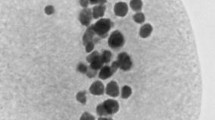Abstract
Cytology of a pentaploid hybrid (2n=60) produced by crossing an autotetraploid (2n=48) of a diploid “race” of Solanum nigrum L. as seed parent with the naturally occurring hexaploid S. nigrum (2n=72) was studied which showed approximately 24II+12I. Chromosome pairing in the gametic complement of the hexaploid was deduced to be 12II+12I and on this basis it is concluded that the natural hexaploid is an autoallohexaploid, which has three sets (genomes) of 12 chromosomes each, two of which are to a large extent homologous to each other. Theoretically the genomic formula can be tentatively written as AAAABB. Since the natural hexaploid does not show any quadrivalents between the four homologous A genomes, chromosome pairing appears to be restricted to bivalent formation by a special genetic mechanism. The probability that S. nigrum could be an autohexaploid, parallelling Pheleum pratense, has been discussed.
Similar content being viewed by others
References
Bhaduri, P. N. (1951). Interrelationships of non-tuberiferous species of Solanum with consideration on the origin of Brinjal (S. melongena L.) Indian J. Genet. 2: 75–82.
Darlington, C. D. (1937). Recent Advances in Cytology. J. & A. Churchill Ltd., London.
Günther, F. (1959). Cytologische Untersuchungen an Solanum nigrum L. Ber. Deutsch. Bot. Ges. 72: 14.
Jorgensen, C. A. (1928). The experimental formation of heteroploid plants in the genus Solanum. J. Genet. 19: 133–211.
Levan, A. (1941) Syncyte formation in the pollen mother-cells of haploid Phleum pratense. Hereditas 27: 243–252.
Müntzing, A. & R. Prakken (1940). The mode of chromosome pairing in Phleum twins with 63 chromosomes and its cytogenetic consequences. Hereditas 26: 463–501.
Nakamura, M. (1937). Cytogenetical studies in the genus Solanum I. Autopolyploidy of Solanum nigrum Linn. Cytologia, Fujii Jubilee Vol. 57–68.
Nordenskiöld, H. (1953). A genetical study in the mode of segregation in hexaploid Phleum pratense. Hereditas 39: 469–488.
Sharma, A. K. & A. K. Bal (1961). Cytological studies in several species of nontuberiferous Solanums with special reference to polyploid types of Solanum nigrum L. Proc. Indian Sci. Congr. Section B. 295–296.
Stebbins, G. L. (1950). Variation and Evolution in plants. Columbia Univ. Press.
Tandon, S. L. & G. R. Rao (1964). Cytogenetical investigations in relation to the mechanism of evolution in hexaploid Solanum nigrum L. Nature, 201: 1348–1349.
Author information
Authors and Affiliations
Rights and permissions
About this article
Cite this article
Rao, M.K. Cytology of a pentaploid hybrid and genome analysis in Solanum nigrum L.. Genetica 42, 157–164 (1971). https://doi.org/10.1007/BF00154846
Received:
Accepted:
Issue Date:
DOI: https://doi.org/10.1007/BF00154846




